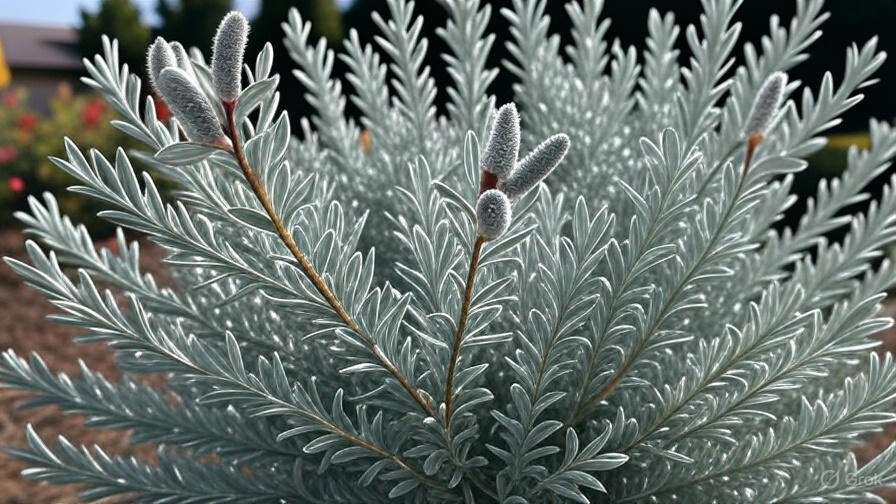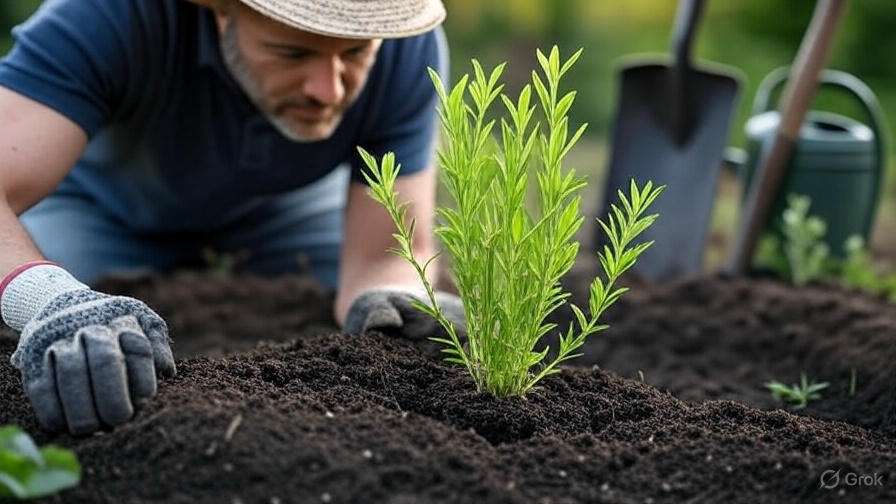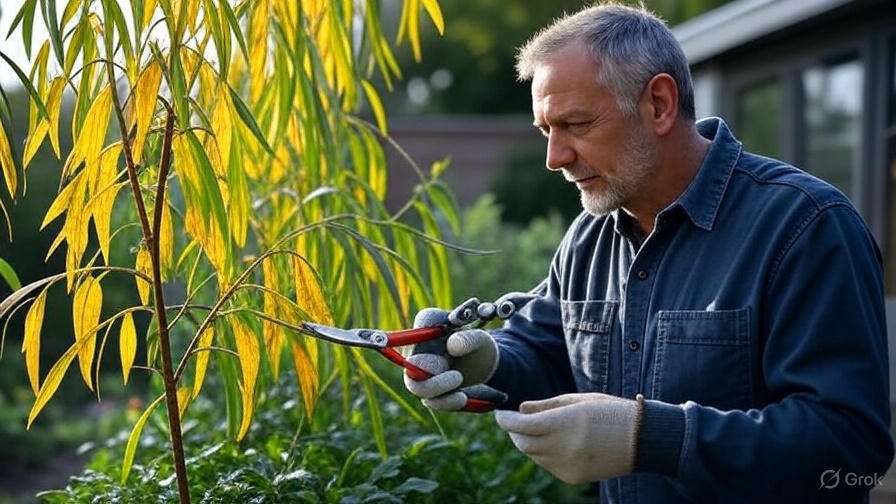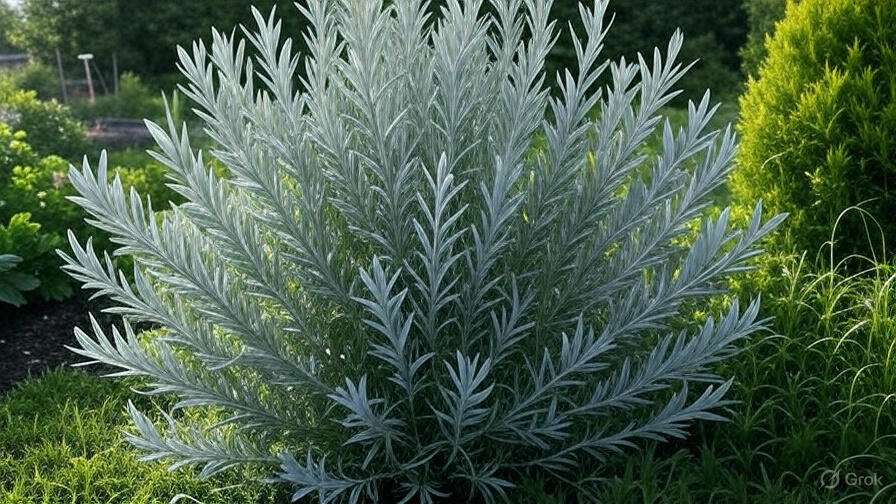
How to Grow and Care for Blue Arctic Willow: Expert Tips for Thriving Plants
The Blue Arctic Willow is a stunning addition to any garden, with its vibrant blue-green foliage and unique, compact form. 
If you’re wondering how to make your Blue-tinted Arctic Willow flourish, you’re not alone! Many gardeners struggle with the best care practices to promote healthy growth and long-lasting beauty. In this guide, we’ll walk you through everything you need to know, from soil and watering tips to pruning and pest control. Keep reading to unlock the secrets to a thriving Blue-tinted Arctic Willow in your garden!
Table of Contents
ToggleWhat is the Blue Arctic Willow? 
The Blue-tinted Arctic Willow (Salix arctica) is a compact, hardy shrub native to the Arctic and subarctic regions. Known for its striking silver-blue leaves and delicate, fluffy catkins, it’s a plant that adds a unique, vibrant touch to any garden or landscape. This willow thrives in cooler climates and is perfect for gardeners looking to add a touch of color to areas with harsh conditions.
Typically growing to about 3 feet in height, the Blue-tinted Arctic Willow is well-suited for smaller spaces like rock gardens, borders, or as a container plant. Its resilience in the face of freezing temperatures makes it a favorite for gardens in northern regions or areas with cold winters.
What sets the Blue-tinted Arctic Willow apart is its adaptability to poor soil conditions and its ability to tolerate both wet and dry environments. It’s a great choice for gardeners seeking a low-maintenance, visually stunning plant that requires minimal care once established.
The soft, silvery leaves and early spring blooms of the Blue-tinted Arctic Willow bring charm and texture to gardens, and it can even attract pollinators like bees, making it a wonderful addition to any eco-friendly garden.
In short, the Blue-tinted Arctic Willow isn’t just beautiful—it’s practical too!
Best Growing Conditions for the Blue Arctic Willow 
To ensure your Blue-tinted Arctic Willow thrives, it’s essential to create the perfect growing environment. Here are the key factors that contribute to its success:
1. Location and Sunlight 
Blue-tinted Arctic Willow loves the sun! Choose a spot that receives full sun for at least 6 hours a day. While it can tolerate partial shade, it will grow more vigorously when exposed to plenty of sunlight. A sunny location also promotes stronger stems and vibrant foliage.

2. Soil Type and Drainage 
The Blue-tinted Arctic Willow prefers well-drained soil. Slightly acidic to neutral soil (pH 6.0 to 7.5) works best. Avoid waterlogged areas as the roots don’t like to sit in stagnant water. If your soil is heavy and clayey, amend it with organic matter to improve drainage.
3. Watering 
This plant is relatively drought-tolerant once established but needs regular watering during its first few months. Keep the soil consistently moist but not soggy. Water deeply to encourage root development, especially during dry spells.
4. Temperature and Hardiness 
The Blue-tinted Arctic Willow thrives in cooler climates. It is hardy in USDA Zones 3-8, meaning it can tolerate cold temperatures but needs protection from extreme heat. In hot regions, consider planting it where it gets afternoon shade to protect it from intense sun.
5. Spacing and Air Circulation 
Space your willows at least 3 to 4 feet apart to ensure good air circulation and room for growth. This prevents overcrowding and minimizes the risk of diseases. Proper spacing will also allow your willow to reach its full potential in terms of height and spread.
By following these simple growing conditions, you’ll set your Blue-tinted Arctic Willow up for success, ensuring it flourishes and adds beauty to your garden for years to come.
With these tips, you’re well on your way to growing a healthy and thriving Blue-tinted Arctic Willow. Enjoy the process and watch your plant grow into a beautiful feature in your garden!
How to Plant Blue Arctic Willow 
Planting Blue-tinted Arctic Willow is straightforward, and with a little guidance, you can have a thriving plant in no time. Follow these expert tips for success!
1. Choose the Right Location 
Blue-tinted Arctic Willow loves full sunlight and well-drained soil. Pick a spot that gets at least 6 hours of direct sunlight daily. Ensure the area has good drainage—this helps prevent water from sitting around the roots, which could lead to rot.
2. Prepare the Soil 
Before planting, loosen the soil in your chosen area. The Blue-tinted Arctic Willow isn’t picky but thrives in slightly acidic to neutral soil. Adding compost or organic matter will help improve soil structure and provide extra nutrients.

3. Planting Your Willow 
- Dig a hole: Make sure it’s about twice the size of the root ball.
- Position the plant: Place the Blue-tinted Arctic Willow into the hole, ensuring the root collar (where the roots meet the stem) is level with the soil surface.
- Fill the hole: Backfill with soil, pressing gently to remove air pockets.
4. Water Well 
After planting, give your Blue-tinted Arctic Willow a good soak. Keep the soil consistently moist (but not soggy) during the first few weeks. Once established, this plant is fairly drought-tolerant.
5. Mulch Around the Base 
To retain moisture and regulate soil temperature, apply a 2-3 inch layer of mulch around the base of the plant. This will also help keep weeds at bay.
6. Space Properly for Growth 
Blue-tinted Arctic Willow can grow wide, so give it enough space—around 3 to 4 feet between each plant. This ensures the willows have room to spread out and reach their full potential.
By following these simple steps, you’ll be well on your way to growing a healthy and beautiful Blue-tinted Arctic Willow!
How to Care for Your Blue Arctic Willow
Caring for your Blue-tinted Arctic Willow is simple once you understand its needs. This hardy plant thrives in a variety of conditions but requires a bit of attention to ensure it grows strong and healthy. Here’s a practical guide to help you care for your Blue-tinted Arctic Willow throughout the year:
1. Watering 
Blue-tinted Arctic Willow prefers consistently moist soil, especially during its first growing season. Water your plant regularly, but avoid letting it sit in waterlogged soil, as this can lead to root rot. Ensure proper drainage, and water the plant deeply to encourage deep root growth. In the warmer months, you may need to water more frequently, while in winter, reduce watering to prevent the roots from becoming soggy.

2. Sunlight 
For optimal growth, your Blue-tinted Arctic Willow needs full sun. Aim for at least six hours of direct sunlight per day. While it can tolerate partial shade, the plant may not reach its full potential in low-light conditions. A sunny spot not only encourages vibrant growth but also strengthens the plant’s resistance to pests and diseases.
3. Soil Requirements 
This willow thrives in well-draining, slightly acidic to neutral soil. While it can grow in a variety of soil types, it prefers loamy or sandy soils. If your garden soil is heavy clay, amend it with organic matter or sand to improve drainage. Regularly check the pH of your soil to maintain optimal conditions for growth.
4. Pruning 
Pruning is essential to keep your Blue-tinted Arctic Willow looking neat and to encourage healthy growth. Trim any dead or damaged branches early in the season to allow for new growth. If your plant gets too large, prune it back in late winter or early spring before new growth starts. Regular pruning helps maintain the plant’s compact shape and keeps it from becoming too leggy.
5. Fertilizing 
While Blue-tinted Arctic Willows are generally low-maintenance, they benefit from occasional feeding. Use a balanced, slow-release fertilizer in early spring, just before the growing season begins. Avoid over-fertilizing, as this can lead to excessive growth with weaker stems. If your soil is rich in nutrients, you may not need to fertilize as often.
6. Pest and Disease Management 
Though Blue-tinted Arctic Willow is relatively pest-resistant, it can occasionally be affected by aphids, spider mites, or willow leaf beetles. Regularly check your plant for any signs of pests or disease. If you spot an infestation, gently rinse the plant with water or apply insecticidal soap. Be sure to remove any infected leaves to prevent the spread of disease.
By following these straightforward care guidelines, your Blue Arctic Willow will thrive and add beauty to your garden for years to come.
Common Problems and How to Solve Them
Growing and caring for Blue Arctic Willow can be a rewarding experience, but like any plant, it comes with its challenges. Here are some common problems you might encounter, along with easy solutions to help keep your plant thriving:
1. Yellowing Leaves 
Problem: If your Blue-tinted Arctic Willow’s leaves turn yellow, it could be a sign of overwatering, poor drainage, or nutrient deficiencies.
Solution:
- Check the soil moisture: Ensure the soil is not waterlogged. Allow the top inch of soil to dry before watering again.
- Improve drainage: If your soil is heavy and doesn’t drain well, consider mixing in some sand or organic matter to help with drainage.
- Fertilize regularly: A balanced, slow-release fertilizer in early spring can provide the nutrients your willow needs for healthy foliage.

2. Stunted Growth 
Problem: If your Blue-tinted Arctic Willow isn’t growing as expected, it might be struggling with poor soil conditions or lack of sunlight.
Solution:
- Sunlight: Ensure your willow is planted in a spot where it gets at least 4-6 hours of direct sunlight each day.
- Soil quality: Blue-tinted Arctic Willows prefer slightly acidic to neutral soil. If your soil is too alkaline, amend it with compost or organic matter to help improve its structure and pH.
- Pruning: Regularly trim any dead or damaged stems to encourage new growth and improve the plant’s overall health.
3. Pests and Diseases 
Problem: Like many plants, Blue-tinted Arctic Willow can attract pests like aphids, spider mites, or fungal diseases like powdery mildew.
Solution:
- Inspect regularly: Check your willow for any signs of pests, such as small bugs on the leaves or webbing. If you find them, wash the leaves with a gentle spray of water or apply insecticidal soap.
- Prevent fungal issues: Ensure good air circulation around your willow. Avoid overhead watering, as this can create a damp environment where fungi thrive.
- Neem oil: For persistent pest problems, consider using neem oil, which is a natural and effective solution against both pests and fungal diseases.
4. Wilting or Drooping 
Problem: Wilting or drooping can occur if the plant is either overwatered or underwatered.
Solution:
- Check soil moisture: Blue Arctic Willow prefers moist but well-drained soil. If the soil feels dry, give it a deep watering, but make sure the pot or ground drains properly to avoid root rot.
- Avoid extreme temperature changes: If your willow is placed in an area with drafts or inconsistent temperatures, it might become stressed. Keep it in a stable environment, away from direct heat sources or cold drafts.
5. Root Rot 
Problem: Root rot is a serious issue that occurs when the roots sit in waterlogged soil for too long.
Solution:
- Watering routine: Stick to a watering schedule where you allow the top layer of soil to dry between waterings. If you’re growing your willow in a pot, ensure the container has proper drainage holes.
- Repot if necessary: If root rot has already set in, gently remove the plant from its pot, trim away any rotting roots, and replant it in fresh, well-draining soil.
By staying on top of these common issues and addressing them promptly, your Blue-tinted Arctic Willow will continue to thrive, adding beauty and charm to your garden!
How to Propagate Blue Arctic Willow
Propagating Blue Arctic Willow (Salix arctica) is a rewarding and straightforward process, perfect for gardeners looking to expand their collection. Whether you’re starting from cuttings or seeds, you’ll be able to grow healthy, thriving willows with a bit of care and patience. Here’s how you can easily propagate your Blue-tinted Arctic Willow to enjoy even more of this beautiful shrub in your garden.
1. Propagation by Cuttings 
One of the most effective ways to propagate Blue Arctic Willow is through stem cuttings. This method is fast and ensures the new plant is genetically identical to the parent.
- Timing: The best time to take cuttings is during late spring or early summer when the plant is actively growing.
- Choose the Right Stem: Select healthy, non-woody stems about 4 to 6 inches long. Avoid any stems that show signs of disease or damage.
- Prepare the Cutting: Trim the cutting just below a node (the part of the stem where leaves emerge). Remove the lower leaves, leaving just the top few.
- Rooting Hormone (Optional): While Blue-tinted Arctic Willow will often root without it, using a rooting hormone can encourage faster root development. Simply dip the cut end of the stem into the hormone.
- Plant the Cutting: Place the cutting in a pot filled with well-draining soil or a mixture of perlite and peat moss. Keep the soil moist but not soggy.
- Create a Humid Environment: Cover the cutting with a plastic bag or a mini greenhouse to maintain humidity. This will speed up the rooting process.
- Wait for Roots: In about 4 to 6 weeks, your cutting should start developing roots. Once rooted, transplant it into the garden or a larger pot.

2. Propagation by Seed 
If you prefer to propagate from seed, here’s how to go about it:
- Collect the Seeds: Blue Arctic Willow produces small, fluffy seeds that can be collected in late summer or early fall. These seeds are lightweight, so be sure to harvest them when they are mature but before they disperse.
- Stratification: To encourage germination, the seeds need a cold period. Place the seeds in a moist paper towel, seal them in a plastic bag, and refrigerate them for about 30 days.
- Plant the Seeds: After stratification, sow the seeds in a seed tray or small pots with a well-draining seed-starting mix. Lightly press the seeds into the soil but don’t cover them completely, as they need light to germinate.
- Care for the Seedlings: Keep the seeds in a warm, sunny location. Ensure the soil remains moist, but not waterlogged. You should see tiny seedlings emerging within 1-3 weeks.
- Transplant the Seedlings: Once the seedlings have a few sets of leaves and are large enough to handle, transplant them into larger pots or directly into the garden.
3. Caring for New Plants 
After propagating, whether by cuttings or seeds, caring for your new Blue-tinted Arctic Willow plants is essential to their success:
- Sunlight: Blue-tinted Arctic Willows love full sunlight. Ensure your new plants get at least 6 hours of direct sun daily for optimal growth.
- Watering: Keep the soil consistently moist, especially during dry spells. However, be sure not to overwater as this can lead to root rot.
- Fertilizing: Fertilize your newly propagated plants with a balanced, slow-release fertilizer once every few months to encourage healthy growth.
With these simple steps, you’ll have plenty of Blue Arctic Willows to add to your garden or share with friends! 
Conclusion
Caring for a Blue-tinted Arctic Willow is a rewarding experience that brings beauty and texture to your garden with minimal effort. By following the essential tips on watering, soil care, pruning, and pest control, you can ensure that your willow thrives for many years. Whether you’re planting it in the ground or in a container, this hardy and low-maintenance shrub can become a stunning focal point in your landscape.

With proper attention to its needs, your Blue Arctic Willow will grow strong and healthy, offering you vibrant foliage and a graceful appearance throughout the seasons. 
Frequently Asked Questions(FAQ)
How fast does the Blue Arctic Willow grow?
The Blue Arctic Willow is a fast-growing shrub, typically reaching 3-6 feet in height in a few years with proper care. Its growth rate depends on factors like sunlight, soil quality, and watering practices.
Can I grow Blue Arctic Willow in a container?
Yes, Blue Arctic Willow can be grown in a container, making it an excellent choice for smaller spaces or patios. Ensure the container has proper drainage and is large enough to accommodate the roots as the plant grows.
How often should I water my Blue Arctic Willow?
Water your Blue Arctic Willow regularly, especially during dry spells, to keep the soil moist but not waterlogged. Once established, it becomes more drought-tolerant, but young plants need consistent moisture to thrive.
What type of soil does the Blue Arctic Willow need?
Blue Arctic Willows thrive in moist, well-drained soil. They can tolerate a variety of soil types, but loamy or sandy soil with good drainage is ideal. Avoid heavy clay soils that retain too much water.
When is the best time to prune Blue Arctic Willow?
The best time to prune Blue Arctic Willow is in late winter or early spring, before new growth begins. Pruning during this time encourages healthy growth and removes any dead or damaged branches.
Why are the leaves of my Blue Arctic Willow turning yellow?
Yellowing leaves can be a sign of overwatering, poor drainage, or a nutrient deficiency. Check the soil moisture, ensure proper drainage, and consider adding a balanced fertilizer if needed.
Does the Blue Arctic Willow attract pests?
While generally pest-resistant, the Blue Arctic Willow can attract aphids or caterpillars. Regularly inspect your plant for pests and use organic insecticides or a strong water spray to control them.
Can I grow Blue Arctic Willow in partial shade?
Blue Arctic Willows prefer full sun, but they can tolerate partial shade. However, for optimal growth and vibrant foliage, ensure the tree receives at least 6 hours of direct sunlight per day


